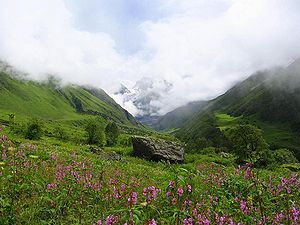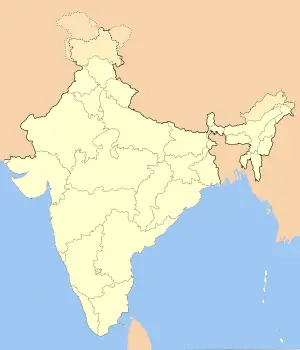Valley of Flowers National Park
| Nanda Devi and Valley of Flowers National Parks* | |
|---|---|
| UNESCO World Heritage Site | |

| |
| State Party | |
| Type | Natural |
| Criteria | vii, x |
| Reference | 335 |
| Region** | Asia-Pacific |
| Inscription history | |
| Inscription | 1988 (12th Session) |
| Extensions | 2005 |
| * Name as inscribed on World Heritage List. ** Region as classified by UNESCO. | |
Valley of Flowers National Park is an Indian national park in the Himalayan area in Uttarakhand, India. Together with Nanda Devi National Park, it forms part of the Nanda Devi and Valley of Flowers National Parks World Heritage Site. The park stretches over an expanse of 87.50 km².
The Valley of Flowers was declared a national park in 1982. This part of Uttarakhand, in the upper reaches of Garhwal, is inaccessible through much of the year. The area lies on the Zaskar range of the Himalayas with the highest point in the national park being Gauri Parbat at 6,719 m above sea level.
History
In 1931 the English mountaineer Frank Smythe stumbled across the Bhyundar Valley, an 8 km long glacier corridor in Chamoli Garhwal. This area, surrounded by snow-capped mountains and carpeted with over 500 species of flowers, soon became a protected site.
Management
There is no settlement in the national park and grazing in the area has been banned. The park is open only in summers between June and October, being covered by heavy snow during the rest of the year.
Fauna
The park is home to tahr, snow leopard, musk deer, red fox, common langur, bharal, serow, Himalayan black bear and a huge variety of butterflies.
Flora
Flowers mostly orchids, poppies, primulas, calendulas, daisies and anemones carpet the ground. Alpine forests of birch and rhododendron cover parts of the park's area.
Species
| Valley of Flowers National Park | |
|---|---|
| IUCN Category II (National Park) | |
| Location: | Uttaranchal, India |
| Nearest city: | Rishikesh, India |
| Area: | 87.50 km² |
| Established: | 1982 |
| Governing body: | Forest Department, Uttarakhand |
| No. | Name of Flowers | Time of flowering |
| 1. | Rhododendron arboreum | February-June |
| 2. | Primula denticuleta | April-July |
| 3. | Iris kemaonensis | June-July |
| 4. | Fritillaria roylei | June-July |
| 5. | Lilium oxypetalum | June-July |
| 6. | Arisaema costautum | June-July |
| 7. | Thermopsisa barbata | June-July |
| 8. | Rosa macrophylla | June-July |
| 9. | Caltha palustris | June-July |
| 10. | Fragaria nubicola | May-July |
| 11. | Saxifraga roylei | July-August |
| 12. | Anemone obtusiloba | June-August |
| 13. | Cypripedium himalaicum | June-August |
| 14. | Rheum australe | July-August |
| 15. | Phlomis oracteosa | June-August |
| 16. | Hackelia uncinata | June-August |
| 17. | Senecio jacquemotiamus | August-September |
| 18. | Ligularia amplexicaulis | July-August |
| 19. | Morina longifolia | July-September |
| 20. | Geum elatum | July-August |
| 21. | Geranium wallichianum | July-August |
| 22. | Impatiense sulcata | July-August |
| 23. | Meconopsis aculeata | July-August |
| 24. | Delphenium roylei | July-August |
| 25. | Aconitum hookeri | August-September |
| 26. | Thalictrum reniforme | July-September |
| 27. | Potentilla atrosanguinea | July-September |
| 28. | Sedum ewersii | August-September |
| 29. | Dactylorhiza hatagirea | June-July |
| 30. | Bistorta affinis | August-September |
| 31. | Stachys sericee | August-September |
| 32. | Nepeta connata | August-September |
| 33. | Pedicularis hoffmeistri | July-August |
| 34. | Swertia hookeri | August-September |
| 35. | Gentiana ornata | August-September |
| 36. | Gaultheria erichophy | August-September |
| 37. | Codonopsis affinis | August-September |
| 38. | Angelica cyelocarpa | July-September |
| 39. | Leontopodium jacotianum | July-September |
| 40. | Saussurea fastuosa | July-September |
| 41. | Campanula latitotia | August-September |
| 42. | Cyananthus lobotus | August-September |
| 43. | Sassurea obvallata | August-September |
| 44. | Cremanthodium ellisii | July-September |
| 45. | Anaphalis triplineruts | July-September |
| 46. | Inula grandiflora | August-September |
| 47. | Aster albescens | July-September |
| 48. | Selinium tenuifolium | August-September |
| 49. | Heracleum pinnatum | August-September |
| 50. | Epilobium latisperma | August-September |
| 51. | Silene setisperma | August-September |
| 52. | Arenaria griffithii | August-September |
| 53. | Corydalis junecea | August-September |
| 54. | Erigerono multiradiatus | August-September |
| 55. | Polygonum molle | August-September |
| 56. | Himalayan Blue Poppy | July-September |
| 57. | Codonopsis viridis | July-August |
| 58. | Origanus vulgare | July-August |
| 59. | Hackelia uncinata | July-August |
| 60. | Salvia hins/lanata | July-August |
| 61. | Smilacina purpurea/oleracea | June-July |
| 62. | Viola biflora | June-August |
| 63. | Rhodiola heterodonta | July-August |
| 64. | Epilohium latifolium | July-August |
External links
- Official UNESCO website entry
- Pictures, Food, Guide, Prices & Acomodation at the Valley of Flowers
- Image Gallery of Journey to Valley of Flowers
- Photos from Valley of Flowers
- Trek to Valley of Flowers
- GMVN Trek details
- Valley of Flowers National Park
| |||||||
| Andaman & Nicobar Islands | Campbell Bay • Galathea • Mahatma Gandhi • Mt. Harriet Island • Middle Button Island • North Button Island • Rani Jhansi • Saddle Peak • South Button Island |
| Andhra Pradesh | Kasu Brahmananda Reddy • Mahavir Harina Vanasthali • Mrugavani • Sri Venkateswara) |
| Arunachal Pradesh | Mouling • Namdapha |
| Assam | Dibru-Saikhowa • Kaziranga • Manas Nameri • Orang |
| Bihar | Valmiki |
| Chhattisgarh | Indravati • Kanger Ghati |
| Goa | Mollem |
| Gujarat | Blackbuck • Gir • Gulf of Kutch • Vansda |
| Haryana | Kalesar • Sultanpur |
| Himachal Pradesh | Great Himalayan • Pin Valley |
| Jammu & Kashmir | Dachigam • Hemis • Kishtwar • Salim Ali |
| Jharkhand | Betla |
| Karnataka | Anshi • Bandipur • Bannerghatta • Kudremukh • Nagarhole |
| Kerala | Eravikulam • Mathikettan Shola • Periyar • Silent Valley |
| Madhya Pradesh | Bandhavgarh • Fossil • Kanha • Madhav • Panna • Pench Sanjay • Satpura • Van Vihar |
| Maharastra | Chandoli • Gugamal • Navegaon • Pench • Sanjay Gandhi • Tadoba |
| Manipur | Keibul Lamjao • Sirohi |
| Meghalaya | Balphakram • Nokrek |
| Mizoram | Murlen • Phawngpui |
| Nagaland | Intanki |
| Orissa | Bhitarkanika • Simlipal |
| Rajasthan | Darrah • Desert • Keoladeo • Ranthambhore • Sariska |
| Sikkim | Khangchendzonga |
| Tamil Nadu | Guindy • Gulf of Mannar • Indira Gandhi • Palani Hills • Mudumalai • Mukurthi |
| Uttar Pradesh | Nawabganj • Dudhwa |
| Uttarakhand | Corbett • Gangotri • Govind • Nanda Devi • Rajaji • Valley of Flowers |
| West Bengal | Buxa • Gorumara • Neora Valley • Singalila • Sundarbans |
| National Parks • Protected areas of India • Ministry of Environment and Forests (India) | |
Credits
New World Encyclopedia writers and editors rewrote and completed the Wikipedia article in accordance with New World Encyclopedia standards. This article abides by terms of the Creative Commons CC-by-sa 3.0 License (CC-by-sa), which may be used and disseminated with proper attribution. Credit is due under the terms of this license that can reference both the New World Encyclopedia contributors and the selfless volunteer contributors of the Wikimedia Foundation. To cite this article click here for a list of acceptable citing formats.The history of earlier contributions by wikipedians is accessible to researchers here:
The history of this article since it was imported to New World Encyclopedia:
Note: Some restrictions may apply to use of individual images which are separately licensed.







